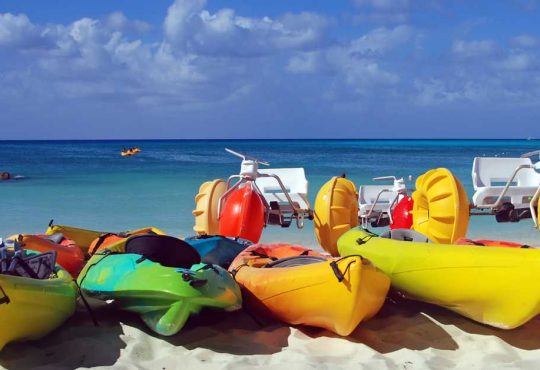Wakeboarding is more than just a water sport; it’s an adrenaline-charged adventure that merges elements from various disciplines to create an experience like no other. Imagine standing on a board designed for the water while being towed behind a boat or cable system, using the wake or wave to launch yourself into the air for jaw-dropping stunts. This sport, which combines the excitement of water skiing, snowboarding, and surfing, provides a dynamic and exhilarating way to push your limits and showcase your skills. Whether you’re carving through the water behind a boat or hitting rails and ramps at a wake park, wakeboarding offers a unique blend of challenge and fun.
In this article, we’ll explore the ins and outs of wakeboarding, from understanding the different types of wakeboarding to essential gear, beginner tips, and advanced techniques. We’ll also dive into why wakeboarding is such a fantastic sport and what you need to consider to ensure a safe and enjoyable experience.
Types of Wakeboarding
1. Cable Wakeboarding
Cable wakeboarding represents a significant evolution in the sport, providing a unique and versatile way to ride. Instead of relying on a boat, riders are towed by an overhead cable system installed at specialized wake parks. This setup creates a continuous pull and a consistent wake, making it easier to perform tricks and stunts without the variability of boat conditions.
How It Works:
- Cable System: The cable system is a series of pylons and cables that form a loop around the park. Riders are attached to the cable via a handle, which is connected to the overhead line.
- Park Features: Wake parks often include a variety of features like rails, kickers, and boxes. These features allow riders to perform tricks such as slides, grinds, and aerial maneuvers.
- Controlled Environment: The consistent pull of the cable and the predictability of park features create a controlled environment where riders can focus on perfecting their tricks.
Best For:
- Trick Enthusiasts: Cable wakeboarding is particularly suited for riders who want to push their limits with tricks and stunts. The availability of features like rails and ramps provides numerous opportunities to try out new maneuvers and combinations.
- Learning and Progression: Ideal for those who want to practice in a stable environment without the need to coordinate with a boat driver. This makes it easier to work on technique and progression, as the cable system provides a consistent pull and less variability in wake conditions.
Advantages:
- Accessibility: Many wake parks are open year-round, offering more opportunities to ride compared to boat wakeboarding, which is often seasonal.
- Cost-Effective: Riding at a cable park can be more economical in the long run, as it eliminates the need for boat rental or maintenance.
- Community and Socializing: Wake parks often foster a strong community atmosphere, providing opportunities to meet other wakeboarders and participate in events and competitions.
2. Boat Wakeboarding
Boat wakeboarding is the classic form of the sport, where riders are towed behind a boat and use the wake created by the boat’s hull to launch into the air and perform various tricks. This traditional method offers a different experience compared to cable wakeboarding, emphasizing natural water conditions and the thrill of open water.
How It Works:
- Boat and Wake: A boat equipped with a tower or pylon creates a wake, which is the primary source of lift for the rider. The shape and size of the wake can be adjusted by modifying the boat’s speed and adding weight to the boat.
- Open Water: Boat wakeboarding allows riders to experience different water conditions, from calm lakes to choppy seas, adding an element of unpredictability to the sport.
- Freedom and Flexibility: Riders have the freedom to choose their riding spots and explore different bodies of water, offering a sense of adventure and variety.
Best For:
- Traditionalists: Ideal for those who appreciate the classic wakeboarding experience and the challenge of natural water conditions. Boat wakeboarding provides the thrill of riding on open water and the satisfaction of mastering tricks in various environments.
- Variety of Tricks: Suitable for riders who want to practice a wide range of tricks, including spins, flips, and grabs. The boat’s wake provides the lift needed for high-flying maneuvers and creative combinations.
Advantages:
- Natural Conditions: Offers the opportunity to ride in different water conditions and enjoy the natural beauty of lakes, rivers, and seas.
- Customizable Wake: The ability to adjust the boat’s speed and weight allows for customization of the wake, enabling riders to create the ideal conditions for their tricks.
- Social and Scenic: Boat wakeboarding often includes a social element, as riders can share the experience with friends and family on the boat, while also enjoying scenic views and exploring new locations.
Essential Gear
Wakeboard: The wakeboard is the primary piece of equipment and varies in size, shape, and flex. Choosing the right board depends on your skill level and riding style. Boards are designed to provide the best performance based on the type of wakeboarding you do. Larger boards provide more stability, while smaller boards offer better maneuverability. Shape and Flex: Determines the board’s performance on the water and in the air.
Bindings: Bindings secure your feet to the wakeboard and are crucial for control and comfort. They come in various styles, including adjustable and fixed. Fit: Ensure bindings are snug but not too tight to avoid discomfort. Support: Choose bindings that provide adequate ankle and foot support.
Tow Rope: The tow rope connects you to the boat or cable system. It should be strong and durable to handle the stresses of wakeboarding. Length: The appropriate length depends on your riding style and whether you’re wakeboarding behind a boat or a cable system.
Life Jacket: A personal flotation device (PFD) is essential for safety. It helps keep you afloat and is required by law for all water sports. Choose a life jacket that fits properly and is approved for water sports.
Beginner Tips
Start with Basics
Mastering the fundamentals of wakeboarding is crucial before diving into complex tricks. By focusing on the basic skills, you’ll build a solid foundation that will make it easier to progress and perform more advanced maneuvers.
Steps to Follow:
- Learn to Stand Up:
- Starting Position: Begin by sitting on the wakeboard with the rope handle securely held in your hands. Position the board perpendicular to the boat.
- Standing Up: As the boat starts moving, the key is to keep your knees bent and your weight centered. Use the tension of the rope to help you stand up gradually. Avoid pulling on the rope too hard, as it can lead to losing balance.
- Body Position: Once standing, keep your back straight and your knees slightly bent. Your shoulders should be aligned with the board, and your arms should be extended, holding the rope handle close to your body.
- Ride Straight:
- Maintain a Straight Line: Focus on keeping your body centered over the board. Look straight ahead rather than down at your feet.
- Control Your Speed: Adjust your position to control your speed. Lean slightly back if you’re moving too fast or forward if you need to increase your speed. Learning to maintain a steady speed helps in developing smooth riding skills.
- Practice Stopping: To come to a stop, gradually ease off the throttle of the boat and let the tension in the rope decrease. Keep your knees bent and your weight centered to avoid falling.
Work on Balance
Balance is one of the most critical aspects of wakeboarding. Maintaining proper balance ensures you stay in control and execute maneuvers effectively.
Tips:
- Knees Bent:
- Absorb Impact: Keeping your knees slightly bent helps absorb the impact of the water and any small changes in the board’s movement. This reduces the risk of falls and provides better control.
- Maintain Stability: Bent knees allow for more flexibility and control over the board, helping you adjust quickly to changes in water conditions or speed.
- Weight Distribution:
- Center Your Weight: Ensure that your weight is evenly distributed over the wakeboard. Avoid leaning too far forward or backward, as this can cause the board to dig into the water or lose balance.
- Foot Position: Your front foot should be slightly ahead of your back foot, and your weight should be evenly distributed between both feet. This position helps in maintaining balance and steering the board effectively.
Advanced Tips
Practice Tricks
Once you’re comfortable with the basics and your balance is solid, it’s time to start incorporating tricks into your wakeboarding routine. Advanced tricks require precise control and timing, so practicing them regularly will help you improve.
Tips:
- Controlled Takeoff:
- Timing: Focus on timing your takeoff to coincide with the peak of the wake. As you approach the wake, prepare to pop off the water by bending your knees and then extending them rapidly.
- Use the Wake: Utilize the wake created by the boat to launch yourself into the air. The height and distance you achieve will depend on how well you time your takeoff and how you handle the board in the air.
- Smooth Landings:
- Land Softly: Aim to land with your knees slightly bent and your weight centered over the board. This helps in absorbing the impact and maintaining balance.
- Avoid Hard Landings: Focus on landing smoothly to reduce the risk of injury. Practice landing techniques in various conditions to build confidence and control.
Experiment with Features
If you’re riding at a cable park, you’ll have access to various features such as rails, kickers, and boxes. These features offer opportunities to expand your trick repertoire and enhance your wakeboarding skills.
Tips:
- Safe Practice:
- Protective Gear: Always wear appropriate protective gear, including a helmet and impact vest, when practicing tricks on features. This helps prevent injuries in case of falls.
- Start Small: Begin with simpler features and gradually progress to more complex ones. Practice basic tricks on smaller features before attempting advanced maneuvers.
- Feature Use:
- Experiment with Different Features: Explore different types of features available at the park, such as rails for sliding or kickers for jumps. Each feature offers unique opportunities to try new tricks.
- Learn from Others: Watch other riders and learn from their techniques. Many wake parks also offer lessons or clinics where you can receive guidance from experienced riders.
Why It’s Great
Thrilling Experience
Wakeboarding is renowned for delivering an unparalleled thrill, thanks to its blend of speed, skill, and high-flying stunts. The sport offers a unique combination of excitement and challenge, making it a standout choice for adrenaline seekers and thrill enthusiasts.
Benefits:
- Adrenaline Rush:
Wakeboarding provides an intense adrenaline rush as you carve through the water at high speeds, launch off wakes, and perform aerial tricks. The sensation of speeding across the water and the sheer excitement of executing complex maneuvers contribute to an exhilarating experience that can be addictive. The thrill of landing a new trick or successfully navigating a challenging feature boosts your heart rate and heightens your senses, offering a unique form of excitement. - Sense of Achievement:
Each new trick or improvement in your wakeboarding skills brings a profound sense of accomplishment. The sport’s progressive nature means that mastering a new maneuver or overcoming a personal challenge leads to a rewarding experience. This feeling of achievement not only enhances your confidence but also motivates you to push your boundaries and strive for further progress.
Skill Development
Wakeboarding is not just about the thrill; it’s also a great way to develop and enhance various physical and mental skills. The sport demands a high level of coordination, balance, and agility, all of which contribute to overall athletic development.
Benefits:
- Continuous Improvement:
As you practice and refine your wakeboarding skills, you’ll find that setting and achieving new goals becomes a regular part of the process. Whether it’s perfecting a specific trick or improving your overall technique, each milestone achieved marks progress and fuels your desire to advance further. This continual improvement fosters a growth mindset and encourages you to stay committed to your training. - Skill Enhancement:
Wakeboarding enhances several key skills, including balance, coordination, and spatial awareness. Balancing on the wakeboard while in motion and during aerial maneuvers requires a strong sense of coordination. Additionally, mastering the timing and execution of tricks improves your overall athleticism and body control, which can translate to better performance in other sports and physical activities.
Social and Fun
Wakeboarding is not only a thrilling sport but also a social activity that can be enjoyed with friends and family. The communal aspect of the sport adds to its appeal, making it a great choice for group outings and creating memorable experiences.
Benefits:
- Group Outings:
Wakeboarding is an excellent activity for spending quality time with others. Whether you’re hitting the water with friends, family, or fellow wakeboarding enthusiasts, the shared experience of riding together enhances the enjoyment. Group sessions often include camaraderie, friendly competition, and encouragement, making the sport even more enjoyable. - Memorable Experiences:
The excitement and fun of wakeboarding often lead to memorable experiences and lasting friendships. From celebrating successful tricks to enjoying the scenic beauty of the water, the sport creates opportunities for unique and cherished moments. The thrill of the ride combined with the social aspect makes wakeboarding a great way to create lasting memories with others.
Additional Considerations
Safety Precautions
Prioritizing safety is crucial in wakeboarding to ensure a fun and injury-free experience. Adhering to safety guidelines and using the appropriate gear helps protect yourself and others while enjoying the sport.
Tips:
- Wear Gear:
Always wear a life jacket to ensure your safety on the water. A well-fitting life jacket is essential for buoyancy and flotation. Additionally, consider wearing other protective gear, such as a helmet and impact vest, to safeguard against potential falls and collisions. These protective measures reduce the risk of injury and provide peace of mind while riding. - Monitor Conditions:
Stay aware of the water conditions and the behavior of the boat or cable system. Pay attention to any changes in water conditions, such as choppiness or debris, which can affect your ride. Also, communicate effectively with the boat driver or cable operator to ensure smooth and safe operation during your session.
Respect Waterway Regulations
Following local regulations and guidelines is important for maintaining a safe and respectful wakeboarding environment. Observing these rules helps ensure a positive experience for everyone on the water.
Tips:
- Follow Rules:
Adhere to local rules and regulations for water sports to avoid fines and ensure safety. Regulations may include speed limits, designated riding areas, and guidelines for interaction with other water users. Familiarize yourself with the specific rules of the area where you’re wakeboarding. - Respect Others:
Be considerate of other boaters, swimmers, and water users. Avoid interfering with their activities and maintain a safe distance from other vessels. Respecting others on the water contributes to a positive and harmonious environment, enhancing the overall enjoyment of the sport for everyone.
Wakeboarding is an exhilarating sport that blends skill, excitement, and the beauty of the water. Whether you’re carving through the wake behind a boat or tackling obstacles at a cable park, it offers a unique way to challenge yourself and have fun. By understanding the different types of wakeboarding, choosing the right gear, and following essential tips, you can make the most of your wakeboarding experience and enjoy all the thrill it has to offer.





